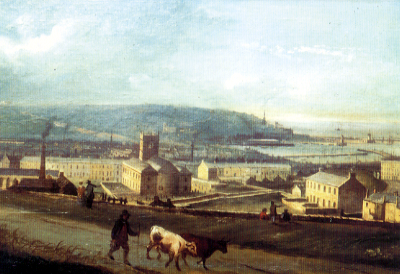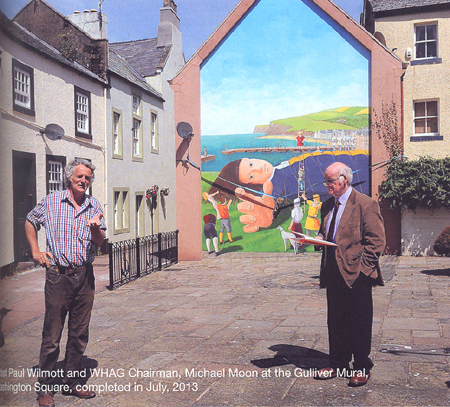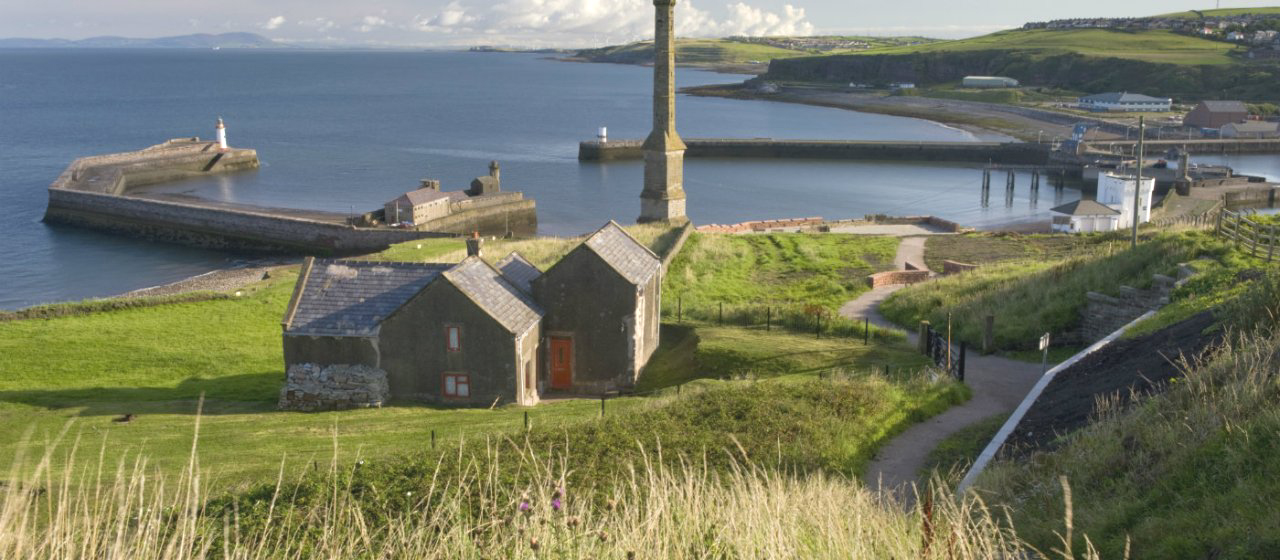
More about the English Lakes
 More about the English Lakes |
THERE is a former inn that overlooks Whitehaven harbour
known by many as Jonathan Swift's house. But the reason for this
association with the creator of Gulliver's Travels is still the
subject of argument among historians.
There is no doubt however that the infant Jonathan Swift was brought
to Whitehaven and the view of the bustling town from the cliffs
above was likely to have lodged in the young child's mind.
Bruce Arnold, from Glenageary near Dublin, is the author of a Swift biography.
 In March of 1999
he wrote: "I recently persuaded the National Library of Ireland to purchase
the rare early 18 century engraving of Whitehaven, by Richard Parr, done from
the Mathias Reid view and based on one of his paintings.
In March of 1999
he wrote: "I recently persuaded the National Library of Ireland to purchase
the rare early 18 century engraving of Whitehaven, by Richard Parr, done from
the Mathias Reid view and based on one of his paintings.
"I regard Whitehaven as of crucial importance in Swift's
infancy, and the survival of the house at Bowling Green as immensley
important. Its preservation and restoration should be undertaken,
and I believe that, internationally, there are organisations and
possibly individuals who would help in this.'' "Swift was
born in Dublin in 1667. The members of his extended Swift family
were involved in the legal profesion, which then centered its
activities around Christ Church Cathedral. The Law Courts were
beside the cathedral.
The following background notes give some guidance...
Jonathan Swift (1667 - 1745)
by Charles A. Read
Originally published in The Cabinet of Irish Literature,
Dublin: 1880
"In the spring of 1667 Jonathan Swift, full cousin to the poet Dryden, and
steward to the Society of King's Inns, Dublin, died in poor circumstances leaving
a widow. Seven months later, on the 30th of November, in a little house in Hoey's
Court the poor widow gave birth to a son who was named Jonathan after his dead
father, and whose life, began thus miserably, was fated to be one constant round
of warfare and suffering, of defeat in victory and of disappointment in success.
Born with a spririt fitting him to rule, the greatest satirist of England felt
in the very first years of his life the cold hand of poverty pressing him to the
earth and branding him a slave. "From his earliest days there seemed to be something
in Swift's life different from other men. His father had been buried at the expense
of the society he served; his mother and himself were kept in existence by the
scanty, and we believe necessarily scanty, bounty of his uncle Godwin. Still,
it seems he had a nurse, and this nurse like other women in after days became
so attached to him that when she was called away to England to the death-bed of
a relative she carried him with her clandestinely. After she was found the mother
refused to insist on taking the child from her, fearing that because he was delicate
he might not be able to stand the fatigue of a voyage from Whitehaven to Ireland.
So in Whitehaven Swift remained three or four years, and there learned to read
the Bible with ease. "When he was about five years of age his nurse carried him
to Ireland again, where alas! there was now no kind mother to receive him, she
having gone to live with a relative at Leicester in England. The little waif was
taken into the family of his uncle Godwin, by whom he was sent to Kilkenny school
when he reached six years of age, and there he remained for about eight years.
According to Sir Walter Scott, his name, cut in school- boy fashion upon his desk
for form, is still shown to strangers. There he learned to celebrate his birthdays
by reading from Job the fierce passage in which that patriarch curses the day
in which it was said in his father's house "that a man-child was born," and there,
no doubt he suffered many an indignity from the poverty-stricken state in which
he was maintained by an uncle who seemed (but in reality was not), rich. "

A 2016 booklet by Margaret Crosby "A Passion for Whitehaven" outlines
the work of the Heritage Action Group, including funding this 2013 mural showing
the town's connection to Gulliver's Travels and Jnoathan Swift.
Previously... The argument over the future of "Jonathan Swift House"
is continued as its owner is threatening demolition if badly needed repairs
are not undertaken. But Copeland Council in around 2006? said that the owner
of Jonathan Swift House has failed to present proposals invited in February.
Edward Caley-Knowles, who lives at the house in Prospect, Kells, claims that
flooding from council land has caused the damage to his house for the past nine
and a half years. And now, literary editor of the Irish Independent and author
of a Swift biography, Bruce Arnold, at the time wrote to the council asking
for action to be taken to prevent further deterioration. It is reputed that
author of Gulliver’s Travels, Jonathan Swift, lived in the house, between
1668 and 1671, when he was between the ages one to four. But Mr Knowles even
goes so far as to claim that because of doubts surrounding the author’s
birthplace, that Jonathan Swift was born in the house.
Indeed, Parsons and White’s 1829 Directory states that he
was born in Whitehaven. Mr Knowles said: “A report by structural
engineers in 1985 stated that repairs to the building would cost
£15,000 and that was 14 years ago so it will cost a lot
more now.” Brain White, head of development and environment
at Copeland, said: “In February we invited Mr Knowles to
send us proposals for work to be done at the house, which we could
then process and look at gaining grant aid from the appropriate
bodies. He has never come up with a proposal. “We are always
willing to hear from people who are having problems with their
property and are able to offer advice and help. There are various
ways in which funding may be obtainable, such as through historical
buildings’ grants or conservation grants, but we need a proposal
from Mr Knowles or Mr Arnold before we can do that. If he wishes
to make a grant application we will be happy to consider it. “With
regards to the flooding, that is a civil matter and one that is
separate from the proposal for grant application.” A legal
battle between Mr Knowles and Copeland was discontinued three
years ago.
 * Jonathan Swift House (See Illustration) is a Grade II listed house, formerly known
as Red Flag. It stands close to the candlestick chimney overlooking
Whitehaven Harbour, the Irish Sea and the Solway Firth.
* Jonathan Swift House (See Illustration) is a Grade II listed house, formerly known
as Red Flag. It stands close to the candlestick chimney overlooking
Whitehaven Harbour, the Irish Sea and the Solway Firth.
* Swiftian footnote... Local historian the late Harry Fancy once said
that: " In the Beacon Centre Collection at Whitehaven there is a "wood"
(i.e. bowling ball) nicely inscribed - (going from memory) Whitehaven Bowling
Club, 1796. There can't be too many of that vintage anywhere, and this was probably
used at the Red Flag Bowling Green. Probably worth having a look!"

Find out more about Whitehaven
Copyright © Lakestay All rights reserved.